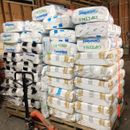Cavity only fiberglass – for use in attic?
mikeysp
| Posted in General Questions on
Hi, I am in zone 4a and am building a pretty good shop/house on a shoe string.
What is the problem of using blow in fiberglass insulation in my vented attic. The package says: “This product is designed for closed-cavit y applications only.”
It is Certainteed Optima.
If the problem is reduced r-value, I can go thicker, if it causes some sort of danger to people or structure, I don’t want to use it. In my ignorance, I declare it is blow-in fiberglass, so just do it. However, in my experience, better to find out the facts before going forward and crying later.
I have about 40 bags of mix/match blow in fiberglass that I got for next to nothing; however, 12 of the bags are Certainteed Optima and the label says “This product is designed for closed-cavity applications only.”
I reached out to Certainteed to find out what is the implication? Loss of R-value? some other problem? I did not get any answer other than restating what the package says. I did not see any contact number for their engineers.
Thanks. -Mike
GBA Detail Library
A collection of one thousand construction details organized by climate and house part
Search and download construction details











Replies
Certainteed seemed pretty adamant about Optima not going in the attic, but without stating why.
If it's going in a non-living space attic, you could experiment and let us know how it went.
Called their 800 number and a rep said she was going to contact their technical manager in morning and try to discover "why?"
If I do not get an answer, I will lean forward and probably blow it down about 8" with the Optima and then cover with the stuff that is suitable. I will also exceed the N95, and use a respirator when blowing it in, in case it is lighter, and they are worried about it floating around.
I'm thinking it might be a coarser grind of material, that is more prone to convective air currents as a result if it's not enclosed. This used to be a problem with older loose fill fiberglass due to the way it was manufactured. If that's the case, using the "for cavity use only" material as the lowest layer, with the "regular" stuff on top, would probably minimize any issues with the material. I would wait to see what the manufacturer's technical people have to say prior to installating the material though.
BTW, I don't really trust N95 masks for use when blowing in this stuff. The installation process is *very* dusty, and N95 masks never seem to stay sealed very well. You are technically supposed to be "fit tested" for an N95 mask to really meet spec, and that's rarely actually done outside of the medical field. I would recommend using a full respirator setup, which is the rubber mask with replaceable filter cartridges as as safer alternative. The rubber masks seal much better, and they aren't terribly expensive. I use a 3M respirator myself, with the funny shaped pink cartridges. You won't need any of the fancy cartridges made for chemical filtration, either, just the basic particulate filter cartridges are fine for this application.
Bill